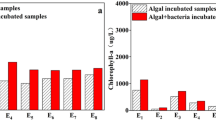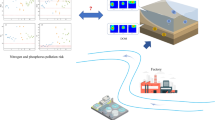Abstract
To improve the understanding of dissolved organic nitrogen (DON) variation characteristics in a biological aerated filter (BAF) used for drinking water treatment, this study investigated the effects of gas–water ratios (0, 0.5:1, 2:1, and 10:1), a controlling factor of BAF operation, on DON characteristics. The dissolved organic carbon (DOC) removal efficiency in the BAF was consistent with DON concentration and increased as the gas–water ratio increased to a certain point, above which the increase gradually decreased. The optimal gas–water ratio in this study was considered to be 2:1 from the perspective of DOC removal and DON reduction. Use of fluorescence regional integration (FRI) and parallel factor (PARAFAC) model to analyze the effects of the gas–water ratio on the spectral characteristics of DON revealed that humic acid-like substances were not sensitive to the gas–water ratio, while protein-like substances were more sensitive. Increasing the gas–water ratio was beneficial to the reduction of biodegradable DON. Correlation analysis showed that the results obtained using FRI were consistent with those obtained using the PARAFAC model under different gas–water ratios.







Similar content being viewed by others
Data availability
All data generated or analyzed during this study were included in this published article (and its supplementary information files).
References
Aryal R, Lebegue J, Vigneswaran S, Kandasamy J, Grasmick A (2009) Identification and characterisation of biofilm formed on membrane bio-reactor. Sep Purif Technol 67(1):86–94. https://doi.org/10.1016/j.seppur.2009.03.031
Baghoth SA, Sharma SK, Amy GI (2011) Tracking natural organic matter (NOM) in a drinking water treatment plant using fluorescence excitation-emission matrices and PARAFAC. Water Res 45(2):797–809. https://doi.org/10.1016/j.watres.2010.09.005
Bro R, Kiers HAL (2003) A new efficient method for determining the number of components in PARAFAC models. J Chemom 17(5):274–286. https://doi.org/10.1002/cem.801
Chang H, Chen C, Wang G (2013) Characteristics of C-, N-DBPs formation from nitrogen-enriched dissolved organic matter in raw water and treated wastewater effluent. Water Res 47(8):2729–2741. https://doi.org/10.1016/j.watres.2013.02.033
Chen W, Westerhoff P, Leenheer JA, Booksh K (2003) Fluorescence excitation-emission matrix regional integration to quantify spectra for dissolved organic matter. Environ Sci Technol 37(24):5701–5710. https://doi.org/10.1021/es034354c
Fdz-Polanco F, Méndez E, Urueña MA, Villaverde S, García PA (2000) Spatial distribution of heterotrophs and nitrifiers in a submerged biofilter for nitrification. Water Res 34(16):4081–4089. https://doi.org/10.1016/S0043-1354(00)00159-7
Feng G, Jia R, Sun S, Wang M, Zhao Q, Xin X, Liu L (2020) Occurrence and removal of 10 odorous compounds in drinking water by different treatment processes. Environ Sci Pollut Res 27(15):18924–18933. https://doi.org/10.1007/s11356-020-08267-5
Gu L, Liu B, Yu X (2010) Dissolved organic nitrogen (DON) in the processes of polluted source water treatment. Environ Sci Technol 55(27–28):3098–3101. https://doi.org/10.1007/s11434-010-4099-y
Han M, Zhao Z, Cui F, Gao W, Liu J, Zeng Z (2012) Pretreatment of contaminated raw water by a novel double-layer biological aerated filter for drinking water treatment. Desalin Water Treat 37(1–3):308–314. https://doi.org/10.1080/19443994.2012.661287
Han M, Zhao Z, Gao W, Cui F (2013) Study on the factors affecting simultaneous removal of ammonia and manganese by pilot-scale biological aerated filter (BAF) for drinking water pre-treatment. Bioresour Technol 145(10):17–24. https://doi.org/10.1016/j.biortech.2013.02.101
Hasan HA, Abdullah SRS, Kamarudin SK, Kofli NT (2011) Response surface methodology for optimization of simultaneous COD, NH4+-N and Mn2+ removal from drinking water by biological aerated filter. Desalination 275(1–3):50–61. https://doi.org/10.1016/j.desal.2011.02.028
Hasan HA, Abdullah SRS, Kamarudin SK, Kofli NT (2013a) On-off control of aeration time in the simultaneous removal of ammonia and manganese using a biological aerated filter system. Process Saf Environ Prot 91(5):415–422. https://doi.org/10.1016/j.psep.2012.10.001
Hasan HA, Abdullah SRS, Kamarudin SK, Kofli NT, Anuar N (2013b) Simultaneous and Mn2+ removal from drinking water using a biological aerated filter system: effects of different aeration rates. Sep Purif Technol 118:547–556. https://doi.org/10.1016/j.seppur.2013.07.040
Hasan HA, Abdullah SRS, Kamarudin SK, Kofli NT, Anuar N (2014) Kinetic evaluation of simultaneous COD, ammonia and manganese removal from drinking water using a biological aerated filter system. Sep Purif Technol 130:56–64. https://doi.org/10.1016/j.seppur.2014.04.016
Hu H, Ren H (2016) Can fluorescence spectrometry be used as a surrogate for predicting the dissolved organic nitrogen and its bioavailable portion in wastewater effluents? Chemosphere 164:299–303. https://doi.org/10.1016/j.chemosphere.2016.08.080
Kang J, Ma T, Zhou Q, Gao J, Xiang Y (2015) New insight into DOC and DON in a drinking water biological aerated filter (BAF) by multimethod and correlation analysis of 3D-EEM. Anal Methods-UK 7(23):9885–9893. https://doi.org/10.1039/c5ay02156a
Lee W, Westerhoff P (2006) Dissolved organic nitrogen removal during water treatment by aluminum sulfate and cationic polymer coagulation. Water Res 40(20):3767–3774. https://doi.org/10.1016/j.watres.2006.08.008
Li W, Qin W, Song Y, Zheng Z, Lv L (2019a) Impact of ozonation and biologically enhanced activated carbon filtration on the composition of micropollutants in drinking water. Environ Sci Pollut Res 26:33927–33935. https://doi.org/10.1007/s11356-018-2700-0
Li Y, Guo J, Li H, Song Y, Hou Y (2019b) Effect of dissolved oxygen on simultaneous removal of ammonia, nitrate and phosphorus via biological aerated filter with sulfur and pyrite as composite fillers. Bioresour Technol 296:122340. https://doi.org/10.1016/j.biortech.2019.122340
Li Y, Xu H, He C, Shen Z, Chen W, Gao L, Lin C, Lin T, Lu C, Shi Q (2019c) Transformation and fate of dissolved organic nitrogen in drinking water supply system: a full scale case study from Yixing, China. Sci Total Environ 673:435–444. https://doi.org/10.1016/j.scitotenv.2019.03.309
Li L, Wang Y, Zhang W, Yu S, Wang X, Gao N (2020) New advances in fluorescence excitation-emission matrix spectroscopy for the characterization of dissolved organic matter in drinking water treatment: a review. Chem Eng J 381:122676. https://doi.org/10.1016/10.1016/j.cej.2019.122676
Liu F, Zhao C, Zhao D, Liu G (2008) Tertiary treatment of textile wastewater with combined media biological aerated filter (CMBAF) at different hydraulic loadings and dissolved oxygen concentrations. J Hazard Mater 160(1):161–167. https://doi.org/10.1016/j.jhazmat.2008.02.100
Liu B, Gu L, Yu X, Yu G, Zhang H, Xu J (2012) Dissolved organic nitrogen (DON) profile during backwashing cycle of drinking water biofiltration. Sci Total Environ 414:508–514. https://doi.org/10.1016/j.scitotenv.2011.10.049
Lu C, Li S, Gong S, Yuan S, Yu X (2015) Mixing regime as a key factor to determine DON formation in drinking water biological treatment. Chemosphere 139:638–643. https://doi.org/10.1016/j.chemosphere.2014.12.059
Ma T, Chen Y, Kang J, Gao X, Guo J, Fang F, Zhang X (2016) Influence of filtration velocity on DON variation in BAF for micropolluted surface water treatment. Environ Sci Pollut Res 23:23415–23421. https://doi.org/10.1007/s11356-016-7578-0
Shen H, Tang X, Wu N, Chen H (2018) Leakage of soluble microbial products from biological activated carbon filtration in drinking water treatment plants and its influence on health risks. Chemosphere 202:626–636. https://doi.org/10.1016/j.chemosphere.2018.03.123
Stedmon CA, Bro R (2008) Characterizing dissolved organic matter fluorescence with parallel factor analysis: a tutorial. Limnol Oceanogr Methods 6(11):572–579. https://doi.org/10.4319/lom.2008.6.572b
Vera GD, Gernjak W, Weinberg H, Farré MJ, Keller J, Gunten U (2016) Kinetics and mechanisms of nitrate and ammonium formation during ozonation of dissolved organic nitrogen. Water Res 108(1):451–461. https://doi.org/10.1016/j.watres.2016.10.021
Wadhawan T, Simsek H, Kasi M, Knutson K, Prüβ B, McEvoy J, Khan E (2014) Dissolved organic nitrogen and its biodegradable portion in a water treatment plant with ozone oxidation. Water Res 54(5):318–326. https://doi.org/10.1016/j.watres.2014.02.009
Wu M, Liang Y, Peng H, Ye J, Wu J, Shi W, Liu W (2019) Bioavailability of soluble microbial products as the autochthonous precursors of disinfection by-products in aerobic and anoxic surface water. Sci Total Environ 649:960–968. https://doi.org/10.1016/j.scitotenv.2018.08.354
Xu B, Ye T, Li D, Hu C, Gao N (2011) Measurement of dissolved organic nitrogen in a drinking water treatment plant: size fraction, fate, and relation to water quality parameters. Sci Total Environ 409(6):1116–1122. https://doi.org/10.1016/j.scitotenv.2010.12.016
Xu X, Kang J, Shen J, Zhao S, Wang B, Zhang X, Chen Z (2021) EEM-PARAFAC characterization of dissolved organic matter and its relationship with disinfection by-products formation potential in drinking water sources of northeastern China. Sci Total Environ 774(1):145297. https://doi.org/10.1016/j.scitotenv.2021.145297
Yamashita Y, Tanoue E (2003) Chemical characterization of protein-like fluorophores in DOM in relation to aromatic amino acids. Mar Chem 82(3–4):255–271. https://doi.org/10.1016/S0304-4203(03)00073-2
Yan NAS, Kunacheva C, Menon S, Webster RD, Stuckey DC (2021) Comparison of soluble microbial product (SMP) production in full-scale anaerobic/aerobic industrial wastewater treatment and a laboratory based synthetic feed anaerobic membrane system. Sci Total Environ 754(2):142173. https://doi.org/10.1016/j.scitotenv.2020.142173
Yang L, Hur J, Zhuang W (2015) Occurrence and behaviors of fluorescence EEM-PARAFAC components in drinking water and wastewater treatment systems and their applications: a review. Environ Sci Pollut Res 22(9):6500–6510. https://doi.org/10.1007/s11356-015-4214-3
Yang B, Wang J, Wang J, Xu H, Song X, Wang Y, Li F, Liu Y, Bai J (2017) Correlating microbial community structure with operational conditions in biological aerated filter reactor for efficient nitrogen removal of municipal wastewater. Bioresour Technol 250:374–381. https://doi.org/10.1016/j.biortech.2017.11.065
Yu X, Ye L, Wei G (2008) Modeling the formation of soluble microbial products (SMP) in drinking water biofiltration. Water Sci Eng 1(3):93–101. https://doi.org/10.3882/j.issn.1674-2370.2008.03.010
Zhang H, Zhang K, Jin H, Gu L, Yu X (2015) Variations in dissolved organic nitrogen concentration in biofilters with different media during drinking water treatment. Chemosphere 139:652–658. https://doi.org/10.1016/j.chemosphere.2014.10.092
Zhang H, Gu L, Liu B, Gan H, Zhang K, Jin H, Yu X (2016) An improved biofilter to control the dissolved organic nitrogen concentration during drinking water treatment. Environ Sci Pollut Res 23(18):18137–18144. https://doi.org/10.1007/s11356-016-6847-2
Zhang Q, Wang C, Jiang L, Qi J, Wang J, He X (2018) Impact of dissolved oxygen on the microbial community structure of an intermittent biological aerated filter (IBAF) and the removal efficiency of gasification wastewater. Bioresour Technol 255:198–204. https://doi.org/10.1016/j.biortech.2018.01.115
Zhang J, Song F, Li T, Xie K, Yao H, Xing B, Li Z, Bai Y (2019) Simulated photo-degradation of dissolved organic matter in lakes revealed by three-dimensional excitation-emission matrix with regional integration and parallel factor analysis. J Environ Sci 90(4):310–320. https://doi.org/10.1016/j.jes.2019.11.019
Zhang Y, Zhang R, Li S, Mostofa KMG, Fu X, Ji H, Liu W, Sun P (2020) Photoâ-ammonification of low molecular weight dissolved organic nitrogen by direct and indirect photolysis. Sci Total Environ 764(4):142930. https://doi.org/10.1016/j.scitotenv.2020.142930
Zhu G, Wang Q, Yin J, Li Z, Zhang P, Ren B, Fan G, Wan P (2016) Toward a better understanding of coagulation for dissolved organic nitrogen using polymeric zinc-iron-phosphate coagulant. Water Res 100(9):201–210. https://doi.org/10.1016/j.watres.2016.05.035
Zhu G, Liu J, Bian Y (2018) Evaluation of cationic polyacrylamide-based hybrid coagulation for the removal of dissolved organic nitrogen. Environ Sci Pollut Res 25(15):14447–14459. https://doi.org/10.1007/s11356-018-1630-1
Acknowledgements
We thank Zhongzhou Water Holding Co., Ltd. for supporting this study. We thank LetPub (www.letpub.com) for its linguistic assistance during the preparation of this manuscript.
Funding
This work was supported by the National High Technology Research and Development Program of China (863 Program) (2012AA062607), the National Natural Science Foundation of China (No. 51708214), the High-level Talent Introduction Program of North China University of Water Resources and Electric Power (40518), and the Key Promotion Project of Henan Province (202102310265) on reactor customization, sample measurements and analyses, experimental consumables purchase, and paper polishing, respectively.
Author information
Authors and Affiliations
Contributions
JK made the experimental program and used FRI technique and PARAFAC model to analyze the spectral data and was a major contributor to the writing of the manuscript. GS provided experimental venues and instruments, guided the experimental process, and analyzed the operating data of the BAF reactor. SL participated in the formulation of the experimental program, was the main contributor to the manuscript review, and provided funding. CS adjusted the operating parameters and was responsible for routine operation of the BAF reactor and for conducting experiments. XG reviewed the manuscript and provided funding.
Corresponding author
Ethics declarations
Ethics approval and consent to participate
Not applicable
Consent for publication
Not applicable
Competing interests
The authors declare no competing interests.
Additional information
Responsible editor: Ta Yeong Wu
Publisher’s note
Springer Nature remains neutral with regard to jurisdictional claims in published maps and institutional affiliations.
Supplementary Information
ESM 1
(PDF 1526 kb)
Rights and permissions
About this article
Cite this article
Kang, ., Song, Gf., Liu, Sl. et al. Spectral characterization of the effect of gas–water ratio on dissolved organic nitrogen variation along a drinking water biological aerated filter. Environ Sci Pollut Res 28, 65743–65751 (2021). https://doi.org/10.1007/s11356-021-15528-4
Received:
Accepted:
Published:
Issue Date:
DOI: https://doi.org/10.1007/s11356-021-15528-4




